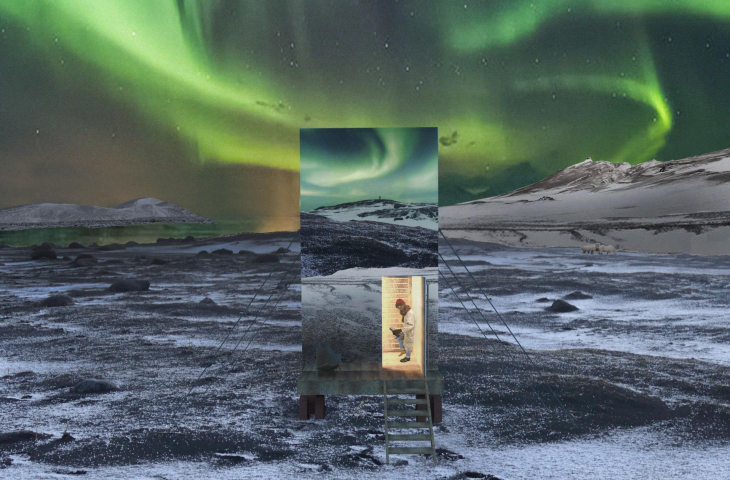Kamila Szatanowska and Paulina Rogalska of the Fala Architektura studio have won first place in a competition to design a tourist facility in the northern region of Iceland. Congratulations!
The goal of the competition, organized by Bee Breeders, was to design a hospitality facility where visitors can enjoy nature and the aurora borealis. The designated project site of nine hectares is located in the northeastern part of Iceland in the vicinity of the picturesque Lake Mývatn, the Krafla volcano and thermal pools. In addition to guest bedrooms, the competition concept should include common spaces and a barn for Icelandic horses. For conservation reasons, the proposed facilities should not have permanent foundations.
objects are covered with mirror cladding
© Kamila Szatanowska, Paulina Rogalska
IN.VISIBLE
How to create an ideal vantage point for aurora watching and an interesting architectural object at the same time? The winners of the competition decided to gently interfere with the Icelandic landscape by introducing peculiar "lanterns." The premise consists of several structures - a communal house and private bedrooms. Referring to the tradition of Icelandic architecture, the authors covered the body of the house for guests and hosts with peat mosaic. In contrast, lighter in form, the mobile sleeping cabins have modern mirror cladding, interacting with the environment. During the day, regardless of placement, the facilities fade into the landscape.
fort - the common house
The common house, reminiscent of a fort, faces north. Its glazed facade frames the view of Lake Mývatn. The sheet of reflecting water merges into a unified image with the sky. The frames of the house's northern elevation, like the cabins, are covered with mirrored cladding. Juxtaposed with the peat facades, they give the effect of fully blending into the landscape. During the night, the mirrors, combined with the light beaming from the interior, give the impression of a luminous screen suspended in space.
© Kamila Szatanowska, Paulina Rogalska
The central viewing axis of the guest house, begins at the first floor level with the entrance to the vestibule. The axis continues through the open courtyard, ending at the north glazing of the spa area, emphasizing the clear functional division of the building. The private and guest parts of the facility are separated from each other. Their common space is the entrance area and a small spa with water supplied from a natural thermal spring. The relaxation area is a meeting place and an auditorium for admiring the aurora borealis. A staircase running through the outdoor courtyard leads to an open, partially covered terrace. Near the house is a stable for ten Icelandic horses and hidden parking spaces. The stable has been partially set into the hillside, covered with peat and greenery, with the front opening up to the freely roaming animals.
© Kamila Szatanowska, Paulina Rogalska
mobile bedrooms with a view of the sky
The sleeping complex is made up of four double cabins (with a sleeping option for four people) and three quadruple cabins (with the possibility of staying for six people). While both forms have the same base, they differ in the additional floor and thus in height. The functional first floor with kitchenette, storage and bathroom has non-transparent walls. Venetian mirrors are the walls of the upper sleeping area of the building, allowing a panoramic view. This allows the user to feel as if they are sleeping under the open sky. The Venetian mirror cladding perfectly reflects the surroundings, and after dusk, with the light on, the bedroom turns into a levitating lantern.
Sleeping cabins are available in several sizes
© Kamila Szatanowska, Paulina Rogalska
non-invasive construction
The structure of the communal house and sleeping cabins is made of glulam. Tall cabins, are protected from strong wind gusts by bracing from steel lashings, attached to anchors grounded in the ground. The system for powering the mobile facilities and emptying the sewage tanks is designed similarly to that of an RV. This allows, if necessary, full freedom to move the facilities. The power supply for the designed complex is based on a renewable energy source popular in Iceland - geothermal.
compiled by {tag:AuthorAiB}
illustrations courtesy of Kamila Szatanowska and Paulina Rogalskaya










































